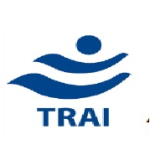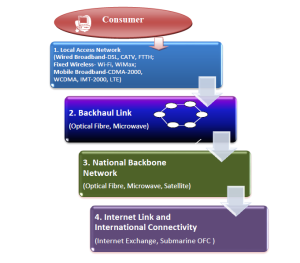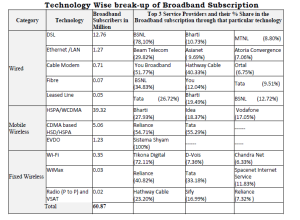 Summary: ‘Broadband’ is ubiquitous now for at least some of us. The technology is already there, but real impediments for adoption of broadband are different. While in India average speed of a typical broadband connection still hovers below 1 Mbps, there’s tremendous room to grow. Let’s not forget that, the dream of ‘Digital India’ by PM Mr.Modi, rides on this slowly moving ‘Broadband’ vehicle. TRAI’s latest consultation paper looks at some of the issues, which are long hurting widespread ‘Broadband’ adoption in the country. Will regulator look it as an ‘Opportunity’ for all?
Summary: ‘Broadband’ is ubiquitous now for at least some of us. The technology is already there, but real impediments for adoption of broadband are different. While in India average speed of a typical broadband connection still hovers below 1 Mbps, there’s tremendous room to grow. Let’s not forget that, the dream of ‘Digital India’ by PM Mr.Modi, rides on this slowly moving ‘Broadband’ vehicle. TRAI’s latest consultation paper looks at some of the issues, which are long hurting widespread ‘Broadband’ adoption in the country. Will regulator look it as an ‘Opportunity’ for all?
As on 31st Mar 2014, India has 252 million Internet subscribers, reports TRAI. Of which, more than 90{af589cdba9d77786c8c861317dbad60bba1e2ebbf56e2ffab874a1b59fde9ce3} subscribers use some kind of mobile wireless broadband to connect, while remaining 7-8{af589cdba9d77786c8c861317dbad60bba1e2ebbf56e2ffab874a1b59fde9ce3} connect via some kind of wired medium. If you compare this number with Q4 2013 mobile subscriber number, we have got around 70{af589cdba9d77786c8c861317dbad60bba1e2ebbf56e2ffab874a1b59fde9ce3} of them, still not connecting to Internet- whopping 630 million in total. Question is- can we help them to connect by ‘2020’ or before?
The latest consultation paper, floated by TRAI, looks at key aspects of entire broadband ecosystem. The paper is divided into four major parts, right from ‘Local Access Network’, where we got wired and wireless medias competing, to backhaul, backbone and Internet Exchange Carrier. Interestingly all three, except local access, are relatively more dependent on ‘Fiber’ (wired) network. From backhaul, along with ‘Microwave’ we got ‘Fiber’, as a major medium to focus on as part of traffic aggregator. So let’s talk about that first.

Creation of NFON via BBNL, to reach more than 250,000 panchayats in the country, was an ambitious goal government has put forward. As on latest data available, out of those 250,000, work was started only for 6410 panchayats in phase-I, despite the fact the investments are already made for procurement of fiber and related material. Then why the progress has been slow? Stakeholders are looking forward to understand, how can we push this slow pace in higher gear in coming years to reach target number of broadband connections via NFON project.
Now coming back to ‘Local Access Network’, which is also the last mile access connecting subscribers. TRAI’s paper looks at ‘Local Access’ in quite detailed manner. While DSL has long enjoyed the monopoly, thanks to BSNL, wireless broadband has recently picked up pace, again thanks to BSNL. Cable modem based BB is quite popular in some part of the country, while Wi-Fi, the relatively popular medium globally, hasn’t showing any sign of take-off. Despite recent spurt of activity by some of telecom operators to deploy Wi-Fi at public and private places, it’s been long way to go for widespread Wi-Fi availability. Fiber (FTTX), another option of local access, owing to its cost and limited reach come distant last in the tally. Can we have that ecosystem support for Wi-Fi and FTTx?
In the end, connecting to local/national/international traffic exchange might be uphill task for a small town ISP. All you need to understand that, a local ISP, who would play an important role in helping broadband penetration to grow in local market, needs easy reach to transit traffic via some form of traffic exchanger, so be it large ISP or Internet Traffic Carrier. But owing to slow growing traffic, the interconnection or capacity charges levied by these big ones mightn’t make a viable case for small players.
Apart from these medium dependent challenges, which we looked at separately, government is also seeking opinion on ‘RoW’ charges to lay fiber nationwide. This is probably the most hotly debated topic and every broadband forum in India has something to say about ‘RoW’ issues in India. I believe TRAI should form a collaborative understanding or ‘RoW’ policy, which gets accepted with DoT, to make nation-wide plan for quick and easy RoW for stakeholders. 
Apart from above consultation, we are also sharing below ‘Ten-points’ for TRAI to look at (Target should be Sub-Rs 500 or even Sub-Rs 1000 broadband):
- Reducing service tax/charge on broadband services.
- Providing some kind of QoS/Service assurance on part of subscribers, if service provider defaults or doesn’t guarantee good services.
- Subsidizing Local Access broadband equipment, which are generally deployed by consumers like Home Routers/Broadband Routers/Wi-Fi Dongles/3G-4G Routers for quick adoption?
- Launching incentive programs for consumers, if they use Government digital services (Electricity Bills/Telephone Bills/Mobile Bills/Passport/Railways/Water/Index-II etc, to quick adoption of broadband.
- Launching incentive programs for service providers upon achieving some target number of subscribers in respective geographies.
- Reducing import duty/levies/taxes on broadband equipments, imported from outside, to make CAPEX cheaper for ISPs.
- Helping ISPs on monetization of deployed broadband infrastructure, like infra sharing, reduced AGR on revenue or even some protection of investments in fiber/local access infra. This is something similar to how DoT is promoting ‘Green Telecom Initiative’ to adoption of green technologies.
- Single window clearance at national/state/local level for Service providers for quick deployment of broadband infra within stipulated timeframe.
- Encouraging ‘Public Hotspot Broadband’ across country by ‘Revenue-Share’ model with guaranteed income of Service providers for long duration.
- Encouraging ‘Broadband Entrepreneurship’ for wannabe ‘Digital Entrepreneurs’ to not-only launch broadband services, but provide value-add services on the top-of-existing infrastructure to make connectivity more meaningful.
Apart from consumers, service providers and local authorities are important stakeholders in broadband ecosystem. Often, service providers, in local market tend to monopolize market with political equations. That’s quite common in Indian local market. The trend was popular when we had ‘Cable TV’ based connection at home, which were largely owned/operated by local MLAs or politicians for no good reasons. The trend was carried forward in ISP market, as ‘Cable TV’s is one of medium to provide Internet services, although not-much popular. To get in the market, monopolized by local players, is still daunting task, especially when there is little support. TRAI’s consultation paper mightn’t talk about this, but I believe ecosystem should have right number of players with right market understanding to make things happen.
In the end, regulator, the decision making body, which we often see is the one who could start positive chain reaction, has uphill task to do. India, with right set of regulations in year 1998-99, made ‘mobile revolution’ a reality. Now fast-forward 15 years, there’s an opportunity to do the same for ‘Broadband Revolution’. Let’s collaborate to make this happen.
(Note: Telecomblogs Media is open to inputs from various stakeholders on the topic of ‘Broadband penetration’. We are also helping small-medium ISPs in India, to roll-out end-to-end broadband services, in respective towns/cities. Interested parties can write to us at [email protected])


